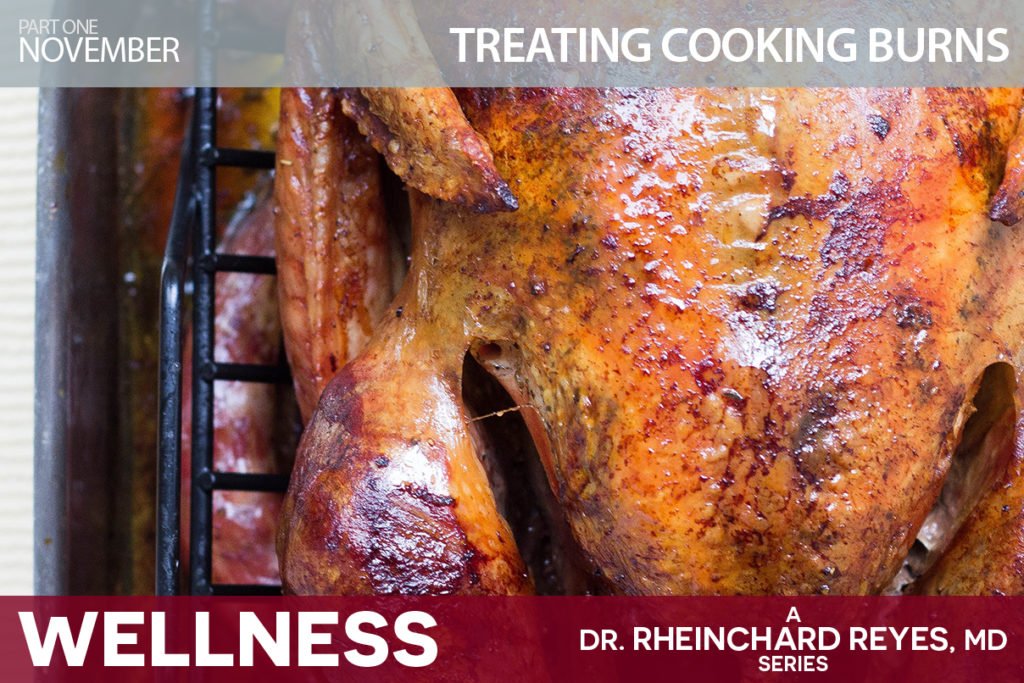Thanksgiving is upon us. This all-American holiday traces its roots to 1621, but it shares with many other countries worldwide the celebration that the blessings of harvest entail. For many, Thanksgiving is wrought with travel, turkey shopping, and the anticipation of meeting up with family and friends. Yet, the most unforgettable snapshot tends to be a bountiful table, decked with all sorts of baked goodies so we can, literally, break bread together.
Don’t Burn The Turkey… or Yourself
Thanksgiving also means a lot of home cooking. Yummy! However, getting burnt during the process is one of the downsides. It is the perfect opportunity to review causes and types of thermal burns, as well as their treatment if you have a mishap.
Causes for cooking-related burns:
- Scalding, mainly from hot liquids, represents the most frequent cause.
- Contact with hot or cold solids, but also from an open oven, pots and pans.
- Electricity, from the electric current of all the kitchen appliances.
- Chemical, although this is very unlikely.
- Flame
Burns are classified by degrees, depending on how deep they penetrate skin surface. Cooking burns usually fall into the first two categories, although you cannot rule out the latter two.
- First-degree. Superficial burns are painful and affect only the outer skin layer. The site looks red, dry, with no blisters.
- Second-degree. They may be more or less severe, but they are always painful and affect two layers of skin, the dermis and epidermis. The site appears red and swollen, and there will normally be blistering.
- Third-degree. They destroy the first two layers and penetrate the subcutaneous tissue. The site may appear white or charred.
- Fourth-degree. These damage bones, muscles, and tendons. They are not painful. There is no sensation in the area since the nerve endings are destroyed.
Treating Cooking Burns (Only First & Second Degrees)
First things first: Stop the burning and/or remove the source. Take off any tight clothing and jewelry.
Step 1: Cool
Hold the burn site under cool —never cold— running water for 10 minutes or immerse in cool water until the pain subsides. This will help with the swelling.
Step 2: Dry & Protect
Dry the burn patting with a clean cloth. Do not resort to aloe vera, butter, or ointments. If anything, use antibacterial cream. Then apply a sterile, non-adhesive bandage. This will also help any blisters from popping.
Step 3: Prevent Shock (only second degree)
Lay the person flat and cover him or her with a blanket. Elevate the feet approximately 12 inches. Elevate the burn site above heart level.
Step 4: Relieve Pain
If necessary, take acetaminophen, ibuprofen, naproxen or aspirin to relieve the pain.
Step 5: Care
Change the bandage daily and reapply the cream, if applicable. Remember to wash your hands before.
Step 6: See your MD
The doctor will assess severity and prescribe medication. Seek medical help regardless… but especially if the pain increases, the infection worsens, you need a tetanus shot, or if you are running a fever.
* For third and forth degree burns, call 911 immediately and follow their lead.
Sources:
https://www.modernmom.com/a03318ae-3b45-11e3-8407-bc764e04a41e.html
https://www.webmd.com/first-aid/thermal-heat-or-fire-burns-treatment#1
https://www.urmc.rochester.edu/encyclopedia/content.aspx?ContentTypeID=90&ContentID=P09575
https://www.omicsonline.org/open-access/burns-definition-classification-pathophysiology-and-initial-approach-2327-5146-1000298.php?aid=93503


